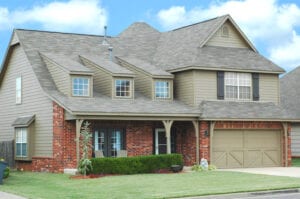The Benefits of Low-Slope Vs. Steep-Slope Roofing
Low-slope roofing and steep-slope roofing have distinct benefits for commercial and residential roofing. By understanding the differences between these two roofing designs, you can select the best option for your property.

What Is Low-Slope Roofing?
Low-slope roofing has a slope below 3:12. This ratio represents the slope in that for every 12 inches of run, there are 3 inches of rise. The run is measured as the horizontal distance from the edge of the roof to the middle of the ridge. The rise is the roof’s increase in height.
So while low-slope roofing is by no means flat, it has a minimal slant. Low-slope roofing is a more common choice for commercial roofing projects. However, it can be used for residential roofing designs as well.
What Are the Benefits of Low-Slope Roofing?
Energy-efficiency
Low-slope roofing limits the amount of air that can circulate through your roof and attic. This can minimize the amount of outdoor air that seeps in through the roof and impacts the temperature of your home.
Cost
Fewer materials are needed to construct a low-slope roof. This leads to a lower total cost of installation when compared to steep-slope roofing.
Safety during installation
Low-slope roofs are easier to walk across, which improves safety during installation.
What Is Steep-Slope Roofing?
Steep-slope roofing has a slope of 3:12 or above. Most homes in the United States feature steep-slope roofing, which has a greater pitch than many commercial roofs. Additionally, with a higher pitch, steep-slope roofing is often considered a practical option in areas that receive high amounts of precipitation.
What Are the Benefits of Steep-Slope Roofing?
Lower maintenance requirements
Water is more likely to sit on low-slope roofing than on steep-slope roofing. Standing water breaks down roofing materials faster, leading to the need for repairs. Steep-slope roofing systems can drain water and debris more effectively, leading to less maintenance.
Reduced UV damage
Steep-slope roofing is less susceptible to UV damage. This is because sunlight doesn’t hit sloped roofing as directly as it hits flat roofing. In the long run, less UV damage can improve the longevity of your steep-slope roof.
Greater range of materials
Many roofing materials are available for steep-slope roofs. Unlike low-slope roofing, overlapped materials like shingles and tiles can be used with steep-slope roofing. This gives homeowners greater control over their roof’s aesthetic.
Consult your local roofing expert to learn more about the right roofing type for your home.
